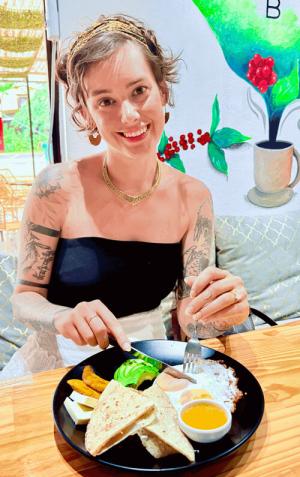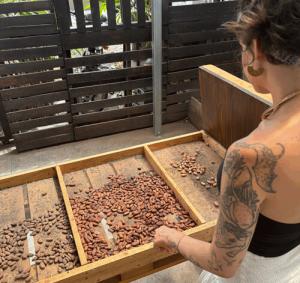Pop Quiz! Where did these foods originate from?
- Tomatoes
- Corn
- Cacao
- Potatoes
- Chilies
- Pumpkins (squash varieties)
- Peanuts
- Quinoa
If you guessed all these foods originated in the Americas, you are correct! The indigenous people who cultivated these foods shared a profound relationship. In Mesoamerica, comprised the modern-day countries of northern Costa Rica, Nicaragua, Honduras, El Salvador, Guatemala, Belize, and central to southern Mexico, the Olmec, Zapotec, Maya, Toltec, and Aztec1 cultivated cacao and chilies for their most important rituals and relied on staple crops like corn, tomatoes, pumpkins, potatoes for sustenance. To the south, the Inca lived across Colombia to Chile in the Andean mountains, cultivating species of corn, cacao, potatoes, pumpkins, as well as peanuts and quinoa. What is now considered a “superfood”, quinoa was the “mother grain” for the indigenous peoples who cultivated it, providing essential amino acids, proteins, and resilience from pests and predators.2
The San Jose Province, located in the Central Valley and surrounded by mountains on all sides, experiences wet conditions from June to November: this season is called the “green season”, or rainy season. At around 2 p.m. each day, you can expect intermittent to flood level rains. I’ve heard from the locals that if it floods one day, the next day should be temperate. But there are exceptions to these natural rules. With the sun set around five, it gets dark quite early here.

While I had time away from the office, I travelled to the Guanacaste Province of Costa Rica. In Guanacaste the climate is much drier and hotter than San José. The temperatures rose 10 to 20 degrees Fahrenheit on this side of the mountains. Guanacaste is known for its sandy beaches and sunsets on the Pacific. On the way through the mountains, I also experienced jungles, volcanos, a variety of wild animals including alligators, and farms. These “microclimas”, or microclimates as they are known in Costa Rica, are what gives Costa Rica its ability to be diverse in climate and food availability.

My morning started at a farm outside of Playa del Coco, enjoying a traditional Costarricense desayuno (breakfast) of tortillas, green plantains, queso fresco (fresh, squeaky cheese), avocado, avocados, eggs, and gallo pinto (rice and beans cooked in a sofrito), and pepper salsa. This breakfast will keep you full for a long time, a staple for farmers working long days in the hot environment.
After breakfast, I toured the farm and learned about cacao and coffee cultivation. The knowledgeable guide told the history of cacao, with its origins first as a cold beverage mixed with corn by the Incas, eventually leading to a cultivation by the Aztecs and Mayans. The Aztecs and Mayans enjoyed the beverage very differently: after roasting the beans, they turned them into paste, added it to hot water, and mixed it with chilies. This mixture that looked like blood would be used in sacrificial rituals.

Next, I sampled coffee while learning about its cultivation. The birthplace of coffee is Ethiopia, not Mesoamerica like cacao. However, the microclimates present in Costa Rica give the country a unique ability to cultivate different kinds of coffee and cacao. The volcanic soil is key in the growth of flavorsome crops, not just coffee and cacao, but the other staple crops mentioned in the beginning of this post. The volcanic soil is also a key ingredient to the thriving vegetation in the ecosystems, providing food and habitat for half a million species of animals, which makes up 5 percent of the world’s biodiversity!3
After the tour, I travelled an hour north to the mountains to Parque Rincón de la Vieja, a UNESCO World Heritage site. Characterized by its incredible biodiversity including flora, fauna, mud pits, fumaroles, and volcanoes, I enjoyed a hike to four waterfalls. After being on the trails, it was time for a relaxing swim in the hot springs, warmed by the nearby volcano, full of natural minerals to rejuvenate and hydrate. It was surprisingly indulgent to bate in warm mud with healing properties from the Rio Negro!
I finished the day on winding roads from the mountains to the sea, passing a labyrinth of wildlife, farms, and fruit stands, watching the yellow, pink, and peach colors of the sun as dipped in the forested elevation. I made it just in time to see the sunset at Playa Del Coco!


There are so many important things I learned about Costa Rica and the region in one day! Most significantly, the region is steeped in culture and history. As recognized by UNESCO, the food here, grown with care in the volcanic soil and nurtured by the rains and oceanic breezes, is Intangible World Heritage. Those fruits, vegetables, and legumes (in the pop quiz) changed the world, providing the crops which the globe grows and consumes each day. These species were cultivated by indigenous people who celebrated a deep relationship with the land and the food it gave. Second, this region is incredibly diverse biologically and culturally. From jungles, to volcanos, to the beach, an area cannot simply be defined by its proximity to the equator, the language spoken, or the food consumed. Each microclimate yields a completely different surprise, full of traditions and rituals.
Although I was away from the office, UNESCO was still with me! From the foods I indulged in, recognized as Intangible Heritage, to enjoying the protected region of Rincón de la Vieja as a Heritage Site, I realized how much UNESCO impacts my life. I am so grateful for the people at my office, and all over the world, who work actively to ensure that we may enjoy and connect over the significant culture in the world.
As you look at your plate, I hope you may think about those who cultivated and say thank you, for the present, to the land, and for the past thousands of years to the people who had the ingenious idea to cultivate these nourishing, flavorsome, and incredible foods. Pura vida
1 https://www.ebsco.com/research-starters/history/mesoamerica
2 https://www.otago.ac.nz/botany/outreach/schoolstudents/quinoainca
3 https://costarica.org/animals/
Lily is a Master’s candidate in International Education at the George Washington University. Her research focuses on the realization of social, cultural, and economic rights of communities in rural contexts.


